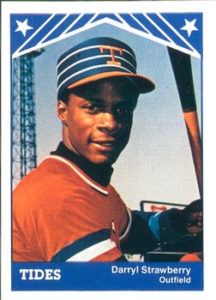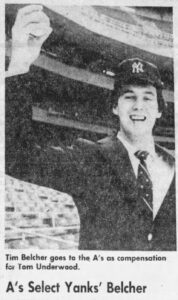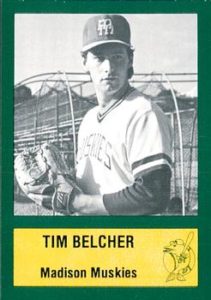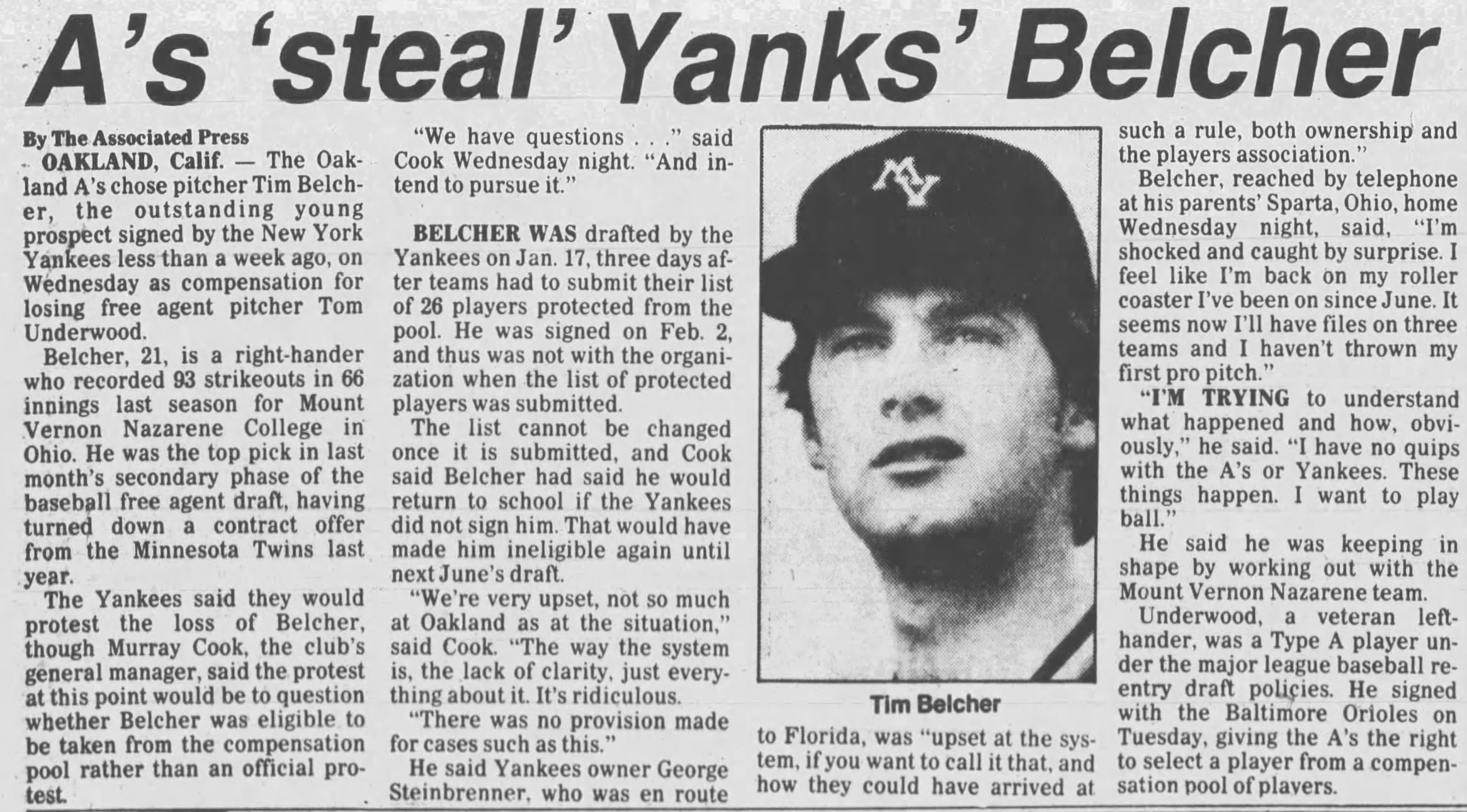Share This Page
One Season in Rocket City
Excerpt from Dale Tafoya’s new book about the 1985 Huntsville Stars

Excerpt from One Season in Rocket City: How the 1985 Huntsville Stars Brought Minor League Baseball Fever to Alabama by Dale Tafoya by permission of the University of Nebraska Press. © 2023 by Dale Tafoya.
Available wherever books are sold or from the Univ. of Nebraska Press 800.848.6224 and at nebraskapress.unl.edu
The Phenom
“It was something out of Field of Dreams, in the scene where the long lines of cars begin pulling off the interstate to get a look at what has come to play ball in the corn-field-turned diamond.”
—John Erardi, Cincinnati Enquirer, 1992
February 1984: The merging of twenty-two-year-old Tim Belcher, baseball’s top amateur pitching phenom, and the filthy rich New York Yankees was sure to be a sexy alliance. The flame-throwing right-hander from Mount Vernon Nazarene College in Mount Vernon, Ohio, had been the first selection of the summer and winter Major League drafts. Belcher seemed destined to become the centerpiece prince of New York’s starting rotation. He reminded many scouts of pitching great Tom Seaver. Like Seaver, the thick-thighed Belcher was right-handed and dragged his knee on the mound when he finished his windup. He dropped so low and drove so hard, his knee bumped the ground when he fired a pitch. The windup generated explosive power behind his pitches. The possibilities for Belcher and the Yankees materialized when New York held the first pick of baseball’s January winter draft in 1984 and selected the six-foot-three, 220-pound sensation.
The Backstory
Despite drawing the spotlight of being a first pick, Belcher only recently had pulled scouts. But they stalked him late, hard, and fast. The country boy from Sparta, a tiny town of 250 people about six miles north of the geographical center of Ohio, Belcher was raised in a farming community. In fact, he worked on several nearby farms as a youth. His family home was on five acres, and he helped care for his grandfather’s race horses on the property. Livestock surrounded him. Some rural youth couldn’t participate in sports because of demanding house chores, but Don and Gladys, Tim’s parents, encouraged their children to have a life away from the home. Growing up, Belcher, a fan of the Cincinnati Reds, wanted to take over for his idol—catcher Johnny Bench. The Reds played 150 miles from his home. The Southern Morrow County teen preferred being a position player over pitching in high school. After leading Highland High School in rebounds on the basketball court, he transitioned into baseball season every spring and played shortstop for the varsity squad. He hit with power. “I hated pitching in high school, I wanted to play every day,” Belcher said in 1983. Even though Belcher pitched some, he was the best high school hitter in North Central Ohio, boasting a .460 batting average in his junior and senior year for the Scots. But no scouts or Division I colleges showed interest in the first-team All-County shortstop.
Mount Vernon Nazarene
Sam Riggleman, the head baseball coach for Mount Vernon Nazarene, a tiny nearby naia college, was the only one coming to Highland to see him. Riggleman liked Belcher’s bat and recruited him to be his third baseman, but also knew he was available to pitch occasionally. The naia, National Association of Intercollegiate Athletics, was far from a hotbed for future Major Leaguers, but Belcher accepted a partial scholarship and attended Mount Vernon in the fall of 1980. “I ended up going there from necessity, really,” remembered Belcher, an instructor for the Cleveland Indians today. “I didn’t have a lot of other opportunities.” The college didn’t offer any full or half scholarships. A Mount Vernon player had never been drafted by a Major League team.
Late in the summer of 1980, Belcher’s promise to Mount Vernon was quickly tested. While pitching in the Ohio State Legion Baseball 22 The Phenom Tournament, he attracted the interest of a Division I program. Jerry France, Ohio University’s head baseball coach, began pursuing him. “I pitched a couple complete games and we ended up winning the state tournament in Athens, Ohio,” remembered Belcher, who posted an 8-1 record for Ashley American, Ohio’s American Legion champions. “Ohio University was out there, and France asked my high school coach about me coming there to pitch on a partial scholarship. But I had already told Mount Vernon I was coming. Before that, I had already made inquiries to Ohio University, and many other colleges, and never received a response. They didn’t recruit me until very late in the summer. But it was too late.” But France persisted and told Belcher he could get out of his promise to Mount Vernon and play for a Division I school, but he stuck with his plans. “I told him, ‘No, I’ll fulfill my promise to Riggleman at Mount Vernon,’” recalled Belcher. “I don’t think it would have turned out much better.”
While Belcher could have made a Division I team as a non-scholarship, walk-on, Mount Vernon was a good fit for the business administration major. The college, a two-hundred-acre campus with only one thousand students, was only twelve miles from his home, so he commuted every morning. The intimacy of Mount Vernon benefited him in the classroom and on the diamond. He enjoyed the personal attention. Belcher played third base and pitched during his freshman year at Mount Vernon. Playing third base for the Cougars, Belcher batted .270 with five homers. On the mound, he was 4-4 with a 5.59 earned run average. By the end of the season, Belcher was the No. 2 starter in the rotation and showing more interest in being on the mound. But some wondered if he had the temperament for a pitcher. He was a fierce competitor, and it was hard for him to conceal his emotions. When he didn’t excel, he got down on himself and was angry after losses. After his freshman season, the nineteen-year-old attended a tryout hosted by Reds’ scout Gene Bennett in Piqua. Belcher was clocked in the high eighties, and the Reds showed interest. Inspired by the tryout, Belcher told Riggleman he wanted to focus on pitching. “By the time my sophomore year rolled around, I started getting attention from The Phenom 23 pro scouts as a pitcher,” said Belcher. “That’s all I did after that.” As a sophomore at Mount Vernon, Belcher was 5-4, fanning seventy-nine in seventy-seven innings. Scouts for the Reds and Los Angeles Dodgers were coming around to see him. Figuring they had a local phenom on their hands, the Reds wanted to keep Belcher a secret like a one hundred dollar bill on a lonely sidewalk.
Belcher drew a wider audience of scouts soon. While compiling a 9-8 record and 4.65 earned run average in his first two years at Mount Vernon, he got his big break before his junior season. In October 1982 Belcher drove to a tryout in Columbus for the U.S. Pan American team at Ohio State. There, he was not just performing to make the Pan Am team. Big league scouts were on hand with radar guns to scope talent. A Cincinnati scout pulled Belcher aside and encouraged him not to throw hard in front of other scouts, but he seized the moment. He fired a fastball that hit over ninety miles per hour on the radar gun in front of the scouts in forty-degree weather. Dozens of perked-up scouts immediately fell in love with Belcher’s arm and were on his trail. Belcher suddenly became the kid every scout was curious about because they never had heard of him. The freshness of Belcher’s lively arm intrigued them. He never had a chance to abuse his arm in high school like other kids did. He was a late bloomer with a ripe arm. “They viewed Tim as a Cadillac that had hardly been out of the garage,” Riggleman once said.
Before Belcher’s junior season in 1983, scouts hunted Riggleman down for Mount Vernon’s schedule to see the fireballer. Belcher’s first game of the season was in Hanover, Indiana, and as he walked off the bus, ten scouts were waiting. Scouts from all over the country descended on the naia school and swarmed the stands. The presence of so many scouts rattled Belcher early on, but he fought through the nervousness. He fired a no-hitter and struck out eighteen batters in a 16–0 mauling of Kenyon College on April 5, 1983. Besides a heater, Belcher featured a slurve and changeup in his arsenal. By May over fifty scouts were showing up to see him. The remarkable story of a goldenarmed, pitching phenom wooing scouts from a tiny Ohio college was 24 The Phenom spreading fast. “It was something out of Field of Dreams, in the scene where the long lines of cars begin pulling off the interstate to get a look at what has come to play ball in the corn-field-turned diamond,” wrote John Erardi of the Cincinnati Enquirer in 1992.
After opening his junior season 1-4, Belcher finished with a 5-4 record and 2.86 earned run average for the 14-14 Cougars. He battled inconsistency and wildness. But Belcher’s ninety-three strikeouts in sixty-six and a third innings made scouts overlook his less than spectacular record. They wanted his arm. He finished the season striking out fifty-one in his final thirty-one innings, allowing only one run. In a matter of months, Belcher, who just hoped to get drafted going into the season, became the top prospect in the country leading up to Major League Baseball’s June Amateur Draft. Belcher sensed he could be picked early in the draft when scouts started asking him for his price tag to sign. He wanted a six-figure signing bonus. All things were pointing to Belcher leaving Mount Vernon after his junior year and signing with a Major League club. The naia All-American was anxious to start his professional career.
As May gave way to June, the Minnesota Twins were preparing to pick first to open the June 6 draft. Baseball insiders felt the talent available in the 1983 draft was mediocre. Baseball America’s predraft scouting report on Belcher opined that “he’s the only pitcher in the draft who can really throw the ball by a hitter.” Central scouting advised that Belcher was the best player available. The Twins were keeping tabs on Belcher. He pitched in the Springfield-Dayton semipro league after his junior season, and Floyd Baker, Minnesota’s Ohio scout, trailed him. Baker said Belcher was the best pitcher he scouted in ten years. Belcher was already 2-0 in the summer and mowing down batters. George Brophy, Twins’ farm director, had seen Belcher at Mount Vernon on June 1 and was smitten by his arm.
The Draft
 Minnesota couldn’t pass on Belcher. They made him the No. 1 pick in the draft and secured the rights to sign him. But their brief public partnership on June 6 was all for show. Belcher and the Twins were never on the same page in negotiations from the jump. Minnesota The Phenom 25 played more hardball than Belcher expected and preferred. It demoralized him. The Twins were in turmoil and owner Calvin Griffith was cutting costs. The Twins weren’t drawing any fans at the Metrodome and had the third lowest attendance in the big leagues. Griffith was blaming the flaws of the Metrodome—Minnesota’s home field—local media, and a dead business community for the club’s decline. What Minnesota offered Belcher was a faster route to the big leagues because they were rushing prospects. But Belcher maintained that if he couldn’t agree to terms with them, he would return to Mount Vernon for his senior year. “A fast-track to the big leagues was attractive for a young kid like me coming from a small college,” said Belcher. “But I wasn’t going to sell my soul for being a No. 1 pick and take a third of what first picks were getting at the time.” Belcher felt right away the dysfunction of the frugal Twins. “I think they thought a small-town, country boy would take any money they offered,” Belcher said. “They had no money. They also drafted Billy Swift and Oddibe McDowell that year but didn’t sign any of us. It was kind of the end of the Calvin Griffith ownership period there.”
Minnesota couldn’t pass on Belcher. They made him the No. 1 pick in the draft and secured the rights to sign him. But their brief public partnership on June 6 was all for show. Belcher and the Twins were never on the same page in negotiations from the jump. Minnesota The Phenom 25 played more hardball than Belcher expected and preferred. It demoralized him. The Twins were in turmoil and owner Calvin Griffith was cutting costs. The Twins weren’t drawing any fans at the Metrodome and had the third lowest attendance in the big leagues. Griffith was blaming the flaws of the Metrodome—Minnesota’s home field—local media, and a dead business community for the club’s decline. What Minnesota offered Belcher was a faster route to the big leagues because they were rushing prospects. But Belcher maintained that if he couldn’t agree to terms with them, he would return to Mount Vernon for his senior year. “A fast-track to the big leagues was attractive for a young kid like me coming from a small college,” said Belcher. “But I wasn’t going to sell my soul for being a No. 1 pick and take a third of what first picks were getting at the time.” Belcher felt right away the dysfunction of the frugal Twins. “I think they thought a small-town, country boy would take any money they offered,” Belcher said. “They had no money. They also drafted Billy Swift and Oddibe McDowell that year but didn’t sign any of us. It was kind of the end of the Calvin Griffith ownership period there.”
 Since No. 1 pick Darryl Strawberry received a signing bonus of $225,000 from the New York Mets in 1980, Belcher figured landing a bonus of somewhere between $100,000 and $200,000 was fair. But Bryan Oelkers, Minnesota’s No. 1 choice the previous season, signed for only $69,500, the largest bonus the club had ever paid. The disenchanted Belcher started traveling with the U.S. Pan Am team in July and hired Chicago agent Scott Boras to evaluate any offers. But Belcher made it clear that Boras was acting as a lawyer and not his agent. Having an agent would have disqualified him from returning to Mount Vernon for his senior year if he didn’t sign. The Twins took offense to Belcher bringing Boras into the mix, and the distrust grew. Belcher wanted more than the three-payment $120,000 Minnesota offered under the stern hand of Griffith. Minnesota claimed they were so poor they needed to borrow the money to sign Belcher. The distance between both sides grew and the negotiations fell apart. By September the Twins cut their offer to $60,000 and eventually disappeared from 26 The Phenom Belcher’s trail. Minnesota never offered Belcher more than $120,000. “The relationship soured quickly and ended unceremoniously,” recalled Belcher. He became only the second No. 1 selection not to sign in the history of the draft. Not signing Belcher was yet another publicity blunder for the Twins. They were ridiculed for not signing or trading him in the spring at the very least. The Chicago White Sox had made Danny Goodwin the first pick of the 1971 draft but never signed him. Belcher came close to being drafted by his favorite team—the Reds. They picked after Minnesota and selected Kurt Stillwell, a high school shortstop from Thousand Oaks, California. Stillwell, eighteen, turned down a four-year baseball scholarship from Stanford University to sign with the Reds.
Since No. 1 pick Darryl Strawberry received a signing bonus of $225,000 from the New York Mets in 1980, Belcher figured landing a bonus of somewhere between $100,000 and $200,000 was fair. But Bryan Oelkers, Minnesota’s No. 1 choice the previous season, signed for only $69,500, the largest bonus the club had ever paid. The disenchanted Belcher started traveling with the U.S. Pan Am team in July and hired Chicago agent Scott Boras to evaluate any offers. But Belcher made it clear that Boras was acting as a lawyer and not his agent. Having an agent would have disqualified him from returning to Mount Vernon for his senior year if he didn’t sign. The Twins took offense to Belcher bringing Boras into the mix, and the distrust grew. Belcher wanted more than the three-payment $120,000 Minnesota offered under the stern hand of Griffith. Minnesota claimed they were so poor they needed to borrow the money to sign Belcher. The distance between both sides grew and the negotiations fell apart. By September the Twins cut their offer to $60,000 and eventually disappeared from 26 The Phenom Belcher’s trail. Minnesota never offered Belcher more than $120,000. “The relationship soured quickly and ended unceremoniously,” recalled Belcher. He became only the second No. 1 selection not to sign in the history of the draft. Not signing Belcher was yet another publicity blunder for the Twins. They were ridiculed for not signing or trading him in the spring at the very least. The Chicago White Sox had made Danny Goodwin the first pick of the 1971 draft but never signed him. Belcher came close to being drafted by his favorite team—the Reds. They picked after Minnesota and selected Kurt Stillwell, a high school shortstop from Thousand Oaks, California. Stillwell, eighteen, turned down a four-year baseball scholarship from Stanford University to sign with the Reds.
Belcher never enrolled for his senior year at Mount Vernon. Boras initially contended that Belcher could attend classes at Mount Vernon and still be eligible to sign only if he didn’t accept a baseball scholarship. But the commissioner’s office ruled in September that Belcher needed to be out of school to be eligible to sign with Minnesota and be out of school for 120 days to be available for the January winter draft. He was still eligible to sign with the Twins until January 9, but it never happened. They had stopped communicating for months. The discontent between both sides reached newspapers and Brophy left Belcher some departing blows: “If you ask me, I think Mr. Belcher has a fear of failure,” Brophy said after not signing him. “When we got our offer up to $120,000, he still wouldn’t sign. He pitches better with his tongue than his arm.”
But many clubs were in love with his arm and eyeing him for the January 17, 1984, winter draft, when 104 players would be available. The consensus was that Belcher would be picked first again. Belcher knew that, too and laid low until the draft, working out at Mount Vernon, where dozens of scouts came to see him. They wanted to hear his side of the story on what happened with Minnesota. He was confident he made the right choice in not signing. As a result of a drawing in New York a few days before the draft, the Yankees were awarded the first pick. New York sent five top scouts to evaluate Belcher. As expected, The Phenom 27 the Yankees drafted Belcher first and had him signed by February. New York gave Belcher a signing bonus of $125,000, and he was scheduled to report to Fort Lauderdale and the Class A Florida State League on February 28. “The Yankees came to one of my workouts at Mount Vernon,” said Belcher. “They drafted and signed me quick. Going in, they knew what they were going to spend. Signing me quickly probably was a mistake, because when they signed me, I had to go on one of their Minor League rosters.”
The Mistake
Signing Belcher too fast haunted New York a week later. The steamy romance between baseball’s top phenom and the storied Yankees was short-lived. A new free-agent system that owners and players negotiated into baseball’s collective bargaining agreement on July 31, 1981, to halt the midseason work stoppage came out of nowhere to kill their plans. As Belcher celebrated his new signing bonus and new life with the Yankees, free agent Tom Underwood, a left-handed reliever for the Oakland A’s in 1983, signed with the Baltimore Orioles on February 7. Because Underwood departed Oakland as a free agent, the twoyear-old free agent compensation system made the A’s eligible for a compensation pick from a pool of unprotected players established by each club. The deadline for New York to submit their list of twenty six protected players was January 13. The players New York protected would be immune from being selected from the compensation pool. Since free agency was born in 1976, the topic of free agent compensation was always a polarizing bargaining topic between owners and players. Owners demanded a compensation system for clubs losing players via free agency to help subsidize the loss. But the players adamantly opposed the owner’s proposal, and the disagreement eventually provoked the 1981 midseason strike.
 The spotlight came on free agent compensation on February 8, when Oakland shocked the baseball world and selected Belcher from a pool of 250 unprotected players. Oakland’s selection of Belcher blindsided the Yankees and Belcher himself. Oakland had never sent any scouts to watch Belcher at Mount Vernon. He was made available to the A’s because New York technically left him unprotected after signing him. 28 The Phenom The system essentially allowed Oakland to land Belcher for Underwood, a thirty-year-old reliever. Underwood played only one more season. “The Yankees didn’t realize they needed to protect him,” said Walt Jocketty, the A’s farm director at the time, “so, we were very fortunate to slip in there and get him.” The Yankees were pissed off and filed a formal protest for losing their top prospect without warning. “We intend to pursue the legality of the selection of Belcher,” Murray Cook, general manager of the Yankees, said at the time. “We feel the selection should be overturned.” Making matters worse for New York was the fact that they were still responsible for Belcher’s signing bonus. Losing Belcher shook the Yankees front office, and a furious Steinbrenner demanded answers immediately. “Tim was not even in the organization when the list was submitted,” Joe Safety, New York’s director of public relations, said in 1984. “It’s grossly unfair. We are victims of an unfair compensation system.”
The spotlight came on free agent compensation on February 8, when Oakland shocked the baseball world and selected Belcher from a pool of 250 unprotected players. Oakland’s selection of Belcher blindsided the Yankees and Belcher himself. Oakland had never sent any scouts to watch Belcher at Mount Vernon. He was made available to the A’s because New York technically left him unprotected after signing him. 28 The Phenom The system essentially allowed Oakland to land Belcher for Underwood, a thirty-year-old reliever. Underwood played only one more season. “The Yankees didn’t realize they needed to protect him,” said Walt Jocketty, the A’s farm director at the time, “so, we were very fortunate to slip in there and get him.” The Yankees were pissed off and filed a formal protest for losing their top prospect without warning. “We intend to pursue the legality of the selection of Belcher,” Murray Cook, general manager of the Yankees, said at the time. “We feel the selection should be overturned.” Making matters worse for New York was the fact that they were still responsible for Belcher’s signing bonus. Losing Belcher shook the Yankees front office, and a furious Steinbrenner demanded answers immediately. “Tim was not even in the organization when the list was submitted,” Joe Safety, New York’s director of public relations, said in 1984. “It’s grossly unfair. We are victims of an unfair compensation system.”
It was hard to argue with Safety. When the Yankees drafted Belcher on January 17, they had already submitted their list of twenty-six protected players on January 13. The list was final. New York didn’t know they needed to protect Belcher from the pool, given they just signed him on February 1. “I signed, but the Yankees already had their protected list in,” recalled Belcher. “As soon as my name appeared on the roster, I became eligible for the compensation pool draft.” Baseball insiders chimed in on Oakland’s shrewd move. “That might be the biggest steal since the Brinks job,” Gary Hughes, a scout for the Yankees said at the time. Phil Seghi, general manager of the Cleveland Indians, discussed the bad optics of losing a No. 1 pick. “That’s the sort of public relations nightmare no team wants,” Seghi said. “Imagine us losing, well, the caliber of a player like Bert Blyleven or Andre Thornton. It would be a disaster.”
The Chicago White Sox pulled a similar move to the A’s when they lost reliever Dennis Lamp to free agency a few weeks earlier. Lamp signed with the Toronto Blue Jays on January 10, and the White Sox proceeded to grab Tom Seaver, a three-time Cy Young Award winner, from the compensation pool on January 20. He was property of the The Phenom 29 Mets, but they left him unprotected. Oakland could have technically picked Seaver from the pool. Chicago, after selecting Seaver, had no way of protecting him by the time Oakland selected on February 8. But Oakland wanted the best player available, Belcher. Belcher, meanwhile, weighed his options. “There may be an opportunity for me to file a grievance if they don’t reverse the decision,” Belcher told woub radio in 1984. “I signed a contract to play for the New York Yankees and I haven’t been given the opportunity to do that. There may be some action I can take with the help of the players’ association.”
Belcher never filed a grievance, but everyone agreed the system needed overhaul. Oakland’s opportunity to scoop Belcher was not what owners and players intended when they came up with the idea of a pool. While owners had insisted on free agent compensation, the new system they pushed hard for was backfiring and bringing division among them. It cast a critical eye on the system. Marvin Miller, executive director of the Major League Baseball Players Association in 1981, helped finalize the agreement before retiring in 1982. Some felt the flawed system was Miller’s departing gift to owners before leaving. For almost two decades, he made the players more powerful and rich, bringing them free agency and bargaining power. “Marvin Miller’s final act was to devise the perfect system to get the owners mad at each other,” Jerry Reinsdorf, former owner of the White Sox, said in 1984. Free agent compensation was doing just that.
As much as free agent compensation was drawing criticism, it was hard to villainize Oakland for doing their homework and using the system to their advantage. “The Yankees wish to make it clear that they find no fault with the management of the Oakland A’s for exercising a different interpretation of the rules,” Mel Southard, Yankees general counsel, said at the time. Oakland narrowed their list down to fifty players prior to circling over Belcher. If New York would have waited four more days to sign Belcher, he would have not been available for Oakland’s taking. But the Yankees felt pressured to sign him fast to keep him from returning to Mount Vernon for his senior year and becoming ineligible. Sandy Alderson, the A’s former general manager 30 The Phenom who orchestrated the move, remembered the context that brought him Belcher. “I think they just didn’t understand the rules, and we quickly realized he was eligible,” remembered Alderson. “The Yankees took him, signed him, and made this opportunity for us to take him. We communicated with the American League about taking Belcher, and they tried to talk us out of it. We ended up taking him. It became somewhat controversial.”
Boldly and shrewdly taking Belcher from the Yankees set the tone for Alderson’s tenure as a baseball executive. “That was Sandy’s first claim to fame as someone who had just taken over our system,” said Keith Lieppman, who began managing in the A’s organization in 1980. “It was one of the first big moves he made, and it turned out to be a real good move for us.” The rest of baseball took note of Oakland’s studied and bold front office. They were a new breed. “Sandy was one of the guys who changed the face of how that office operated,” said Belcher. “He wasn’t just a former player sitting in a smoke-filled room with scouts. He had a law degree. He was a real analytical, well-read guy who was shrewd. Being the wise man he was, he noticed the No. 1 pick and the best prospect available was eligible for selection.”
The Fallout
Back in New York, angry Yankees fans flooded the phone lines at Yankee Stadium to protest losing Belcher, prompting New York to file a formal protest with Lee MacPhail, director of baseball’s Player Relations Committee, on February 14. They asserted they did not draft Belcher until January 17, four days after they filed their list of twenty-six protected players. Only players in the organization on the January 13 deadline should have been eligible for the compensation pool, they contended. The Yankees insisted they had no means of protecting Belcher.
MacPhail had ruled on New York’s affairs the previous summer, when he handed down a highly publicized ruling against them. On July 24, 1983, home-plate umpire Tim McClelland erased Royals third baseman George Brett’s two-run, game winning home run against New York at Yankee Stadium for allegedly having too much pine tar on the barrel of his bat. Kansas City filed a protest, and MacPhail overruled The Phenom 31 the umpires, crediting Brett with the home run and the Royals with the win for what came to be known as the Pine Tar Incident. MacPhail handed the Yankees more bad news in 1984. He tossed out the protest and ruled that Belcher belonged to Oakland. “The selection of Tim Belcher by Oakland shall stand, and the contract shall be assigned from Greensboro to the Oakland organization,” MacPhail ruled.
Belcher remembered how the Yankees reacted when Oakland took him. “They were scrambling,” he said. “They were calling me to find a way to disallow the pick. They hinted that if I petitioned to Major League Baseball that I had my heart set on playing in New York and that I grew up a Yankee fan, they would not approve the pick and make Oakland pick someone else. But at that point, Oakland seemed like a better opportunity for a young prospect. They offered me a quicker ascent to the big leagues than New York did at the time.”
Steinbrenner was so angry, his front office was never the same. He stripped power from his executives and reassigned others. Cook’s role as general manager was diminished. He was reassigned to scouting carrying a clipboard. Steinbrenner ordered him to remain in New York when the Yankees left for spring training. Bill Bergesch, formerly vice president of baseball operations, was transferred to baseball administration. Steinbrenner made Clyde King, a longtime close advisor, the new general manager. Bergesch and Cook left the organization by October. Cook was hired as the Montreal Expos’ new general manager in September. Cincinnati hired Bergesch as new general manager in October. Oakland invited Belcher to big league camp for spring training until Minor League camp opened at Scottsdale Community College in early March. Before arriving in Phoenix, Arizona, Belcher and Boras had flown to Oakland for a few days to meet A’s executives. In Phoenix, Belcher shared lockers with Tim Romano in the spring. One of Belcher’s highlights of being in big league camp with Oakland was meeting Joe Morgan, the A’s forty-year-old second baseman. Belcher, a fan of Cincinnati’s Big Red Machine teams of the 1970s, idolized Morgan, growing up in Ohio. But Belcher garnered his own attention, as the twice minted No. 1 pick swaggered into Phoenix for spring training on February 25. 32 The Phenom “He had the phenom label with the buzz of money when he got here,” said Brad Fischer, Belcher’s first manager in pro ball. He drew more attention than A’s big leaguers. Belcher threw batting practice for ten minutes at Phoenix Municipal Stadium, Oakland’s spring training headquarters. Everyone stopped and watched as he hit ninety-four miles an hour on the radar gun. He overmatched everyone. In Florida twenty-one-year-old Roger Clemens, another fire-balling phenom in Boston’s organization, was blowing batters away during the spring. Both phenoms were building the stage to become baseball’s next version of Nolan Ryan and Seaver.
 When spring training ended, Oakland sent Belcher north to Madison, Wisconsin, to begin his professional career playing for the Madison Muskies, one of the A’s Single-A clubs, in the Midwest League. Many forecasted Belcher would dominate the Midwest League like Juan Nieves, an eighteen-year-old pitching prospect for the Milwaukee Brewers, did the prior season. One of the reasons Oakland favored sending Belcher to Madison as opposed to Single-A Modesto was they wanted him close to Wes Stock, the A’s Minor League pitching coach. Stock planned on spending a great deal of time in Madison in 1984. While New York was on the hook for Belcher’s $125,000 bonus, Oakland paid his salary—a little under $1,000 a month. Belcher was not short of confidence when he began his professional baseball journey. “I just want to be moved along as rapidly as I can,” Belcher said in 1984. “If I’m ready to pitch in aa ball right now, that’s where I want to be. If I’m ready for aa in July, that’s where I want to be.”
When spring training ended, Oakland sent Belcher north to Madison, Wisconsin, to begin his professional career playing for the Madison Muskies, one of the A’s Single-A clubs, in the Midwest League. Many forecasted Belcher would dominate the Midwest League like Juan Nieves, an eighteen-year-old pitching prospect for the Milwaukee Brewers, did the prior season. One of the reasons Oakland favored sending Belcher to Madison as opposed to Single-A Modesto was they wanted him close to Wes Stock, the A’s Minor League pitching coach. Stock planned on spending a great deal of time in Madison in 1984. While New York was on the hook for Belcher’s $125,000 bonus, Oakland paid his salary—a little under $1,000 a month. Belcher was not short of confidence when he began his professional baseball journey. “I just want to be moved along as rapidly as I can,” Belcher said in 1984. “If I’m ready to pitch in aa ball right now, that’s where I want to be. If I’m ready for aa in July, that’s where I want to be.”
Belcher’s wishes materialized as scheduled. After opening the season 6-0 for Madison, he posted a 9-4 record with a 3.57 earned run average in sixteen starts there. By July Oakland moved Belcher up to Double-A, and he played in the Eastern League for the Albany-Colonie A’s. “I had a really good first year,” said Belcher. “By the end of the year, I was in Double-A pitching in the Eastern League playoffs.” Besides fighting through a rough four-game losing streak for Madison in June, Oakland was pleased with his development. During that stretch, Belcher learned to battle through his struggles on the mound. “Timmy had grit and The Phenom 33 was a battler,” said Chip Conklin, Belcher’s Minor League teammate. “You knew he was going to go out and battle for you.”
The attention and pressure intensified for Belcher in Albany, the state capital of New York. The region was still reeling over the Yankees losing him. New York had filed another grievance and was awaiting a ruling from Bowie Kuhn, Major League Baseball’s commissioner. Ben Bernard, owner of the Albany-Colonie club, recalled Belcher’s East Coast arrival. “The New York media came with satellite trucks for his first outing. They all wanted to talk about this kid stolen from the Yankees.”
In front of a hoard of media at Heritage Park, Albany-Colonie’s ballpark, on July 14, Belcher was shelled early. He issued eight walks in one and two-thirds innings. He walked five straight batters at one point, taking the loss. “He started his first game in Albany by walking the first three guys and coughing up a home run,” recalled Bernard. “It happened to him like two or three times in a row. It was the awfullest thing you could imagine for the kid. He was so upset, we flew his girlfriend in. I suggested we start him on the road to get the pressure off him. But he was a great young kid.” Belcher was tough on himself and a ferocious competitor. “Tim was a little hot-headed,” recalled Rick Stromer, a former Minor League teammate. “If he got rocked, he was not afraid to throw at the other team.” Mike Ashman, another teammate in Albany in 1984, remembered pulling him aside on the bus on occasion to calm him. “He was really hard on himself,” said Ashman. “He felt like he had to win every game and strike everyone out. He was so competitive.” His nickname was soon “Hurricane” Belcher.
Belcher finished the season in Albany with a 3-4 record and a 3.33 earned run average. He admitted to being tired and losing zip on his fastball from pitching 153 innings at Madison and Albany combined in 1984, the most he ever pitched in a season. He battled wildness. “Tim had a strong arm, but he couldn’t control the baseball sometimes,” said Wayne Giddings, Belcher’s teammate in Madison. “But Oakland was going to give him every opportunity to keep throwing until he found the strike zone.” 34 The Phenom.
Belcher finished the season strong, boasting an earned run average of 1.96 in his last four starts. He was pleased with his first year despite the chaos. “It was overwhelming at times,” said Belcher. “I’m suddenly on a roster with a bunch of older, experienced guys in Albany. It was kind of a whirlwind for me. It was not long before I was on the campus of Mount Vernon Nazarene College pitching in the snow during the spring.” Belcher reported to Arizona instructional league in Scottsdale after the season. Being invited to instructional league was a shot in the arm for him. It meant he was in Oakland’s plans. Belcher finished his first year as a professional with a 12-8 record and 3.49 earned run average.
Bowie Kuhn finally ruled on New York’s grievance and confirmed for good Belcher’s fate in September. He ruled that Oakland’s selection of Belcher was valid but awarded the Yankees a bonus pick at the conclusion of the first round of baseball’s summer draft in 1985. “Oakland was not at fault in making the selection, but in my judgment, the Yankees certainly are deserving of some compensation themselves as a means of producing a fairer result,” Kuhn said at the time. Players and owners eliminated free agent compensation in the next collective bargaining agreement in 1985.
With distractions behind him, Belcher zeroed in on his goal of making the big leagues by 1986.
Harvey Dorfman, Oakland’s new psychologist, promoted a mental side of the game throughout the organization that behooved Belcher. “Harvey was very instrumental in helping him overcome some of the difficulties of learning how to play the game correctly and managing yourself,” said Lieppman. “Tim was an outright very athletic kid—a great pitcher—and he benefited from this whole new style that we presented in our system when the new regime came in.” After passing through the hands of two clubs since June, Belcher made himself at home in the A’s organization. “Maybe the A’s will be better for me,” Belcher said in 1984. “I hope I made the right decision.”
About the Author:
Dale Tafoya is the author of Billy Ball: Billy Martin and the Resurrection of the Oakland A’s and Bash Brothers: A Legacy Subpoenaed (Potomac Books, 2008). His work has appeared in the New York Daily News, New York Post, Sports Illustrated, The Athletic, Baseball Digest, and other noteworthy publications.
Powered by BlueHost
Monetize your website with Monumetric!



